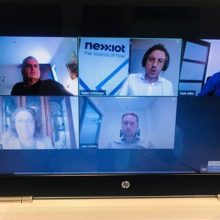
The expert panel included senior representatives from Bane Nor in Norway, Trafikverket in Sweden, Vayla in Finland, along with technology vendors OSI Soft and Stimio. The discussion focused on the major infrastructure and digitisation investments taking place in Nordic and Scandinavian regions to enhance productivity, capacity, safety and sustainability.
“I’ve been involved in these ‘Rise of IoT and Big Data in Rail’ events since they began in 2015”, says MacGregor. “They are essential for the industry to benchmark developments, discuss opportunities and also collaborate internationally with lessors, operators, railway undertakings and technology vendors to ensure the solutions fit the customers’ needs and are both interoperable and future proof.”
Ben Holliday, founder of Rotaia Media, said:
“It’s exciting to see the progress being made as infrastructure managers harness the latest digital trends to achieve their goals of increasing capacity, reducing delays, enhancing safety and driving down costs”.
Investment in the future
The panel discussion covered topics like how to evaluate and test new ideas, how to build interdisciplinary teams, how to clean and prepare data for analysis, how domain knowledge can be best integrated from experienced industry experts and how it is possible to fast track innovation for multi-stakeholder projects.
With huge investments currently being made in rail infrastructure across the Nordic and Scandinavian regions, it’s more important than ever to define a culture that can successfully manage change. One of the key outcomes of the discussion is that all panelists agreed a holistic, integrated and multi-disciplinary approach is of critical importance to achieve success. To support this, the industry must define a language to communicate ideas efficiently and minimise the risks of complexity and differing stakeholder objectives. 2020 has thrown new challenges and raised awareness of interdependencies and the fragile nature of a post globalized world. The need for clear communication is increasing at all levels.
Much of the rail infrastructure in Nordic and Scandinavian regions has not been significantly updated for over 100 years. Now Trafikverket in Sweden is in the process of spending over 5 billion euros to support the increased traffic and hit its targets for fossil fuel free transport by 2045. Veyla in Finland and Bane Nor in Norway are also significantly scaling up investments in Digital Rail infrastructure and making procurement decisions on new digitisation equipment. Everyone’s mission includes elements of safety, efficiency and sustainability. The challenges of a warming world will impact colder regions significantly as changes to substructure, soil, and water levels increase risks and uncertainty.
Big data as a game changer
The sum of IoT and digital rail infrastructure is big data. “In order to fast track innovation to facilitate positive outcomes for all stakeholders, we must ask fundamental questions about what we want to achieve, where our priorities stand today, how they are likely to evolve and how we can integrate all kinds of domain knowledge to create meaningful models and improved processes”, underlines MacGregor. Matt Miller from OSI Soft emphasised at the event the importance of considering and improving ‘time to value’. To do this, one must have effective feedback from all parties involved so models can be adjusted quickly taking new opportunities from concept to prototype and then to MVP (Minimal Viable Product) as quickly as possible. Iterative working in highly specialized cross disciplinary groups is now required as standard. This is also the case for projects in other regions characterized by significant investments which means the stakes are high.
In a time of aging infrastructure, increasing costs, decreasing rail ridership, changing workforce and new customer expectations on flexibility, security and privacy, the challenge is clear. Tools such as Digital Twins and VR applications must be developed to improve transparency and support the flow of critical information. Sensors must be integrated to automate checks and controls. Work culture must be redefined to fit the needs of a changing rail ecosystem. Quality management must be prioritised and processes must evolve to support the needs of all stakeholders. “With the arrival of digitization, rail is set for a high-speed journey into an exciting new future full of opportunities providing the right configurations can be found”, MacGregor says as he summarizes his outlook.
